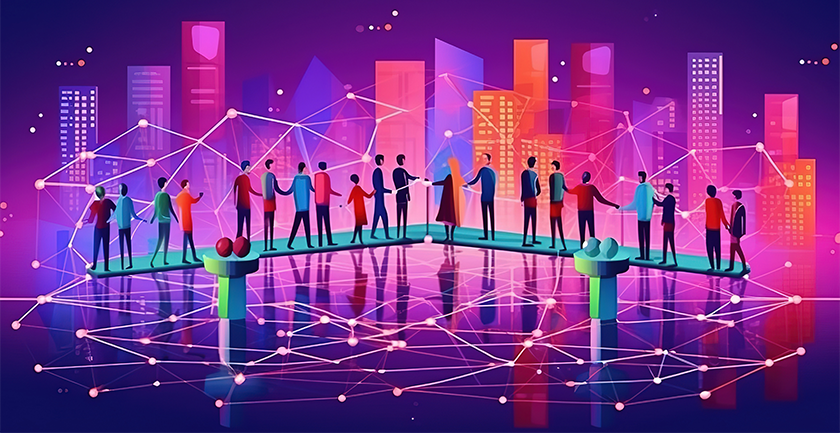In a world where connections and relationships weave the fabric of success and prosperity, networking events stand as the bedrock of professional growth. Akin to tributaries of a great river, these gatherings bring together individuals from diverse backgrounds, fostering opportunities for cooperation and collaboration, career advancement and the profound exchange of ideas.
However, as the scale and complexity of these events grow, so too do the challenges of productivity and efficiency. Here is where AI steps in. A potent ally, AI emerges as a catalyst to shape a future of networking events that would have been deemed to be the realm of fantasy merely years ago.
The heartbeat of every networking event reverberates with the quest to find kindred spirits amid a sea of new faces. The old-fashioned way of exchanging business cards and initiating serendipitous conversations, while charming in their own right, has its inherent limitations. AI, with its cerebral prowess, can now scrutinize attendee profiles, interests and goals to offer sagacious suggestions for connections that carry genuine promise.
Picture yourself stepping into a buzzing networking event, where your smartphone has already lined up the most fitting candidates—individuals who share your passions or goals—for you to meet. Much like a curator selecting works of art they know will delight you, these personalized AI-tendered recommendations exponentially increase the likelihood of fruitful interactions, ensuring that you make the most of your time spent networking.
Organizing network events often resembles navigating a labyrinth, replete with scheduling intricacies, registration management and the orchestration of vital resources. The sheer number of moving parts and demands are staggering, yet our real-world Jarvis steps in to simplify the entire process through automation.
AI-powered tools are able to analyze historical data, predict attendance and optimize event layouts with unmatched precision: seating arrangements, gastronomic offerings and strategic marketing efforts are allocated with optimal efficiency. Chatbots and virtual assistants are put in place to handle routine inquiries and registration, freeing human event planners the freedom to focus on more strategic tasks.
Security, the quiet sentinel of every networking event, takes center stage at large-scale gatherings, especially where sensitive information and valuable connections are at stake. AI dons the mantle of vigilance, discreetly monitoring attendee behavior and swiftly detecting anomalies that signal potential threats. Its discerning eye can spot and flag unusual movement or activity, alerting security personnel to preemptively respond.
AI-infused facial recognition technology not only accelerates and streamlines the check-in process, it ensures only individuals with the proper clearance access to restricted zones. Moreover, AI scans social media and online chatter, identifying potential security risks and nipping them in the bud before they occur
Modern-day networking events transcend geographical borders, drawing participants from all four corners of the globe. However, language can pose a formidable barrier to communication. With the help of AI-driven language translation tools to bridge this divide in real time, attendees are able to converse effortlessly across language boundaries.
These innovative tools go beyond basic translation, adapting to industry-specific terminologies and contexts, ensuring that the rich nuances of professional discourse are not lost in translation. This capability opens doors to cross-cultural collaboration and knowledge exchanges that would have been challenging to achieve otherwise.
The strength of AI is its ability to sift through vast volumes of data at speeds humans can only dream of. For networking events, this translates to collecting and analyzing attendee data, including interactions, interests and engagement levels. This valuable information equips organizers with insights into audience preferences, enabling them to fine-tune future events for maximum impact.
AI generates post-event reports and analytics, giving attendees and sponsors a clear picture of their ROI. This data-driven approach arms event organizers with the knowledge to make informed data decisions, attract sponsors and elevate the overall quality of the event.
In the wake of the pandemic, virtual events have surged in popularity. AI can enhance virtual networking experiences with unparalleled realism and engagement. VR and AR, driven by AI, can create immersive environments that make attendees feel like they are physically present in a real-world event. In these spaces, they can explore virtual exhibition halls, interact with 3D avatars of fellow participants and attend virtual workshops and seminars. What’s particularly impressive is that AI algorithms not only ensure these experiences feel realistic but are tailored to meet individual preferences.
The integration of AI into networking events goes beyond mere efficiency, it unlocks a world of possibilities for meaningful connections and collaborations. With AI as a guiding force, networking events are poised to evolve from just gatherings into dynamic hubs for innovation, constant learning, and professional growth. As we continue to embrace AI’s dazzling potential, the future of networking events looks brighter than ever, setting the stage for a revolution in the way we connect, learn and grow.

